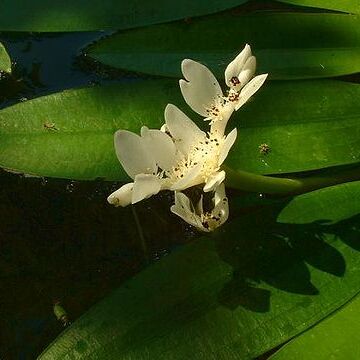Small to medium-sized perennial herbs growing in seasonally wet soil or submerged in temporary pools or similar habitats, rarely in permanent water; leaf-blades and flowers often floating on the surface of the water. Tuber globular to oval or more irregular in shape, usually grey to brown with very numerous roots from upper part Leaves usually with a long petiole and a distinct blade with a few parallel primary veins and numerous transverse secondary veins, but in some species, e.g. A. vallisnerioides, the leaf-blade is linear. Inflorescence with spirally or unilaterally arranged flowers in a loose or dense simple or bifid spike; spathe present, but usually very early caducous. Flowers with white, yellow, mauve or bluish-violet petal-like appendages (tepals), rarely with tepals lacking. Stamens with yellowish or brown anthers often early turning blackish; connnective sometimes protruding into a conical appendage; pollen-grains monosulcate, borne in monads. Ovaries green, blue or lilac. Follicles bottle-shaped with a distinct beak, containing 1–12 rounded to fusiform seeds, which are often prominendy longitudinally ribbed.
Perennial lactiferous freshwater herbs, rhizome short tuberous with fibrous roots. Leaves radical, submerged or floating, base sheathing, oblong to linear, entire or crisped, often long-petiolate; nerves lengthwise parallel, connected by numerous oblique transverse veins. Spike emerging from the water, simple or 2-8-forked, without bracts, subtended by a mostly caducous basal sheath (spathe). Flowers bisexual (rarely by abortion unisexual), small, spicate-scapose, white, rose, purple, yellow or yellowish-green. Perianth segments 2 (1-3, or absent), equal or unequal, usually persistent. Stamens in 2 rows, 6 (or more), free, hypogynous, persistent; filament filiform; anthers extrorse, small, 2-celled. Pollen subglobose or ellipsoid. Gynaecium superior, apocarpous; carpels 3-6, sessile, each with a simple style. Ovules 1-8 (or more), anatropous. Mature carpels inflated, opening along the back. Seeds without endosperm; outer testa often loose; embryo straight, elongate.
Herbs with milky sap. Leaves sheathing at base; axillary scales present. Inflorescences branched [unbranched], projected above water. Flowers bilaterally symmetric, sessile; stamens 6--18--[50]; filaments distinct; anthers 2-locular; pistils 2--6[--9], sessile. Fruits: beak terminal [lateral], curved or straight. Seeds: endosperm absent; seed coat single or double. x = 8.
Characters of the family. Spp. 30, of Africa, Asia, New Guinea and Australia. Adventive sp. 1.
Morphological characters and geographical distribution are the same as those of the family.
Scapes simple or bifid, with unilateral flowers
Perianth-segments 1-3, white or coloured
Styles distinct.
Aquatics

